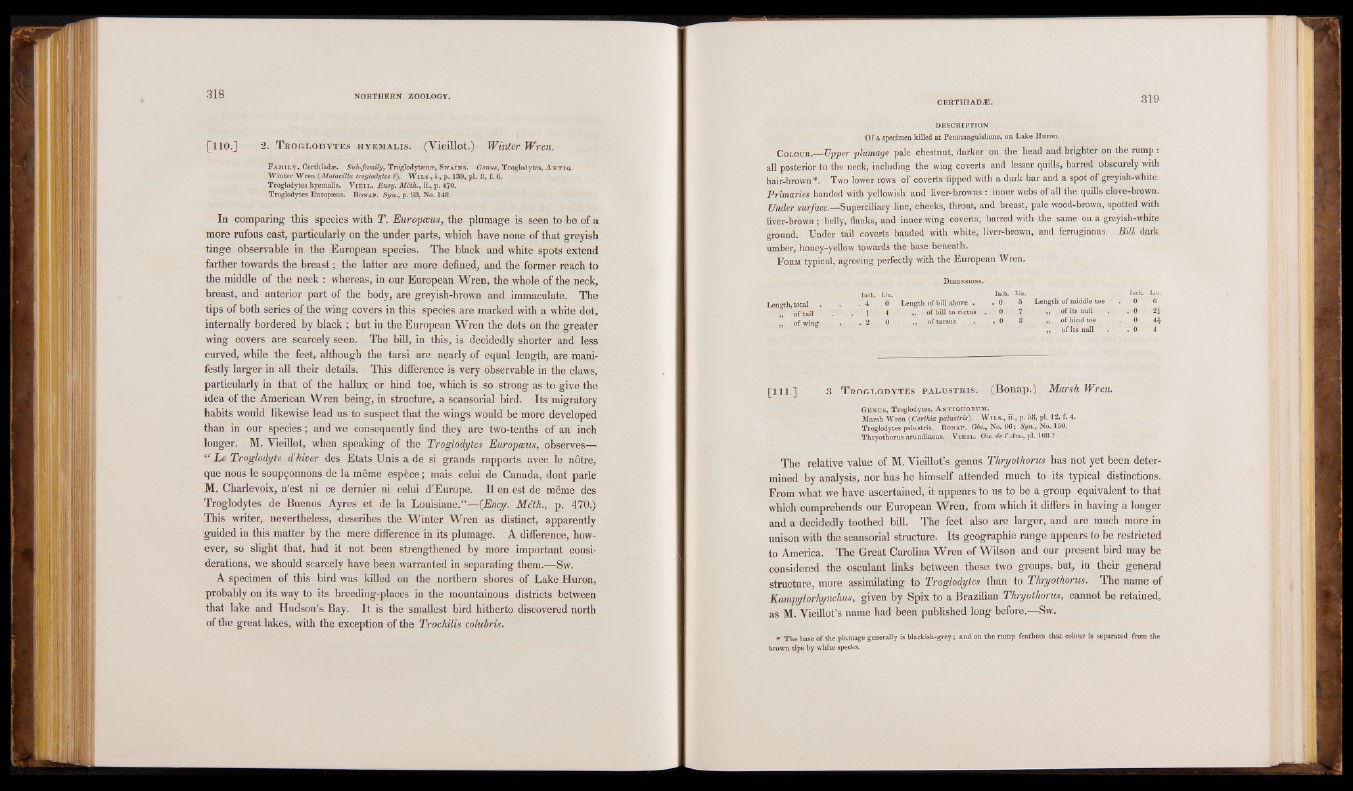
[110.] 2. T r o g l o d y t e s h y e m a l is . (Vieillot.) Winter Wren.
F a m il y , Certhiadæ. Sub-family, Troglodytænæ, Sw a in s. Genus, Troglodytes, A n t iq .
Winter Wren (Motacilla troglodytes ?). Wils., i., p. 139, pi. 8, f. 6.
Troglodytes hyemalis. V i e i l . Ency. Mêth., ii.,p. 470.
Troglodytes £uropæas. B onap. Syn., p. 93, No. 148.
In comparing this species with T. Europceus, the plumage is seen to be of a
more rufous cast, particularly on the under parts, which have none of that greyish
tinge observable in the European species. The black and white spots extend
farther towards the breast ; the latter are more defined, and the former reach to
the middle of the neck : whereas, in our European Wren, the whole of the neck,
breast, and anterior part of the body, are greyish-brown and immaculate. The
tips of both series of the wing covers in this species are marked with a white dot,
internally bordered by black ; but in the European Wren the dots on the greater
wing covers are scarcely seen. The bill, in this, is decidedly shorter and less
curved, while the feet, although the tarsi are nearly of equal length, are manifestly
larger in all their details. This difference is very observable in the claws,
particularly in that of the hallux or hind toe, which is so strong as to give the
idea of the American Wren being, in structure, a scansorial bird. Its migratory
habits would likewise lead us to suspect that the wings would be more developed
than in our species ; and we consequently find they are two-tenths of an inch
longer. M. Vieillot, when speaking of the Troglodytes Europceus, observes—
§| Le Troglodyte d'hiver des Etats Unis a de si grands rapports avec le nôtre,
que nous le soupçonnons de la même espèce ; mais celui de Canada, dont parle
M. Charlevoix, n’est ni ce dernier ni celui d’Europe. Il en est de même des
Troglodytes de Buenos Ayres et de la Louisiane.”—(Ency. Me'th., p. 470.)
This writer, nevertheless, describes the Winter Wren as distinct, apparently
guided in this matter by the mere difference in its plumage. A difference, however,
so slight that, had it not been strengthened by more important considerations,
we should scarcely have been warranted in separating them.—Sw.
A specimen of this bird was killed on the northern shores of Lake Huron,
probably on its way to its breeding-places in the mountainous districts between
that lake and Hudson’s Bay. It is the smallest bird hitherto discovered north
of the great lakes, with the exception of the Trochilis coluhris.
DESCRIPTION
Of a specimen killed at Penetanguishene, on Lake Huron.
C olour.— Upper plumage pale chestnut, darker on the head and brighter on the rump :
all posterior to the neck, including the wing coverts and lesser quills, barred obscurely with
hair-brown*. Two lower rows of coverts tipped with a dark bar and a spot of greyish-white.
Primaries banded with yellowish and liver-browns : inner webs of all the quills clove-brown.
Under surface.—Superciliary line, cheeks, throat, and breast, pale wood-brown, spotted with
liver-brown ; belly, flanks, and inner wing coverts, barred with the same on a greyish-white
ground. Under tail coverts banded with white, liver-brown, and ferruginous. Bill dark
umber, honey-yellow towards the base beneath.
F orm typical, agreeing perfectly with the European Wren.
Dimensions.
Inch. Lin. Inch. Lin. Inch. Lin.
Length, total . . . 4 0 Length of bill above . . 0 5 Length of middle toe . 0 6
-X of tail . . 1 4 of bill to rictus . 0 7 W of its nail . . 0 2 |
of wing ,. . 2 0 of tarsus . . 0 8 .. of hind toe . 0 4£
„ of its nail . . 0 4
[111.] 3. T r o g l o d y t e s p a l u s t r is . (Bonap.) Marsh Wren.
Ge n u s , Troglodytes, A N T iauoauM .
Marsh Wren ( Certhia palustris'). W il s ., ii., p. 58, pi. 12, f. 4.
Troglodytes palustris. B o n a p . Obs., No. 6 6 ; Syn., No. 15 0.
Thryothorus arundineus. V i e i l . Ois. de VAm., pi. 108 ?
The relative value of M. Vieillot’s genus Thryothorus has not yet been determined
by analysis, nor has he himself attended much to its typical distinctions.
From what we have ascertained, it appears to us to be a group equivalent to that
which comprehends our European Wren, from which it differs in having a longer
and a decidedly toothed bill. The feet also are larger, and are much more in
unison with the scansorial structure. Its geographic range appears to be restricted
to America. The Great Carolina Wren of Wilson and our present bird may be
considered the osculant links between these two groups, but, in their general
structure, more assimilating to Troglodytes than to Thryothorus. The name of
Kampylorhynchus, given by Spix to a Brazilian Thryothorus, cannot be retained,
as M. Vieillot’s name had been published long before.—Sw.
* The base of the plumage generally is blackish-grey; and on the rump feathers that colour is separated from the
brown tips by white specks.